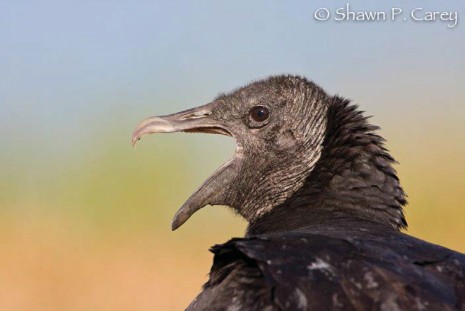David M. Larson

Black Vulture. (Photograph © Shawn P. Carey)
Birds eat the darnedest things. Snowy Owls specialize on lemmings in the Arctic and eat other mammals, waterfowl, and dainty bits here in New England. And Great Horned Owls don’t shun a tasty skunk. But vultures have diets that most birds will not touch and possibly could not survive.
New World vultures, such as Turkey and Black, consume fairly rotten meals. They play a vital role in scavenging dead animals, cleaning up messes, and recycling. Turkey Vultures depend on the odor of decomposing flesh to locate their meals while Black Vultures are more visual hunters. Because they lack the sharply hooked bills and raking talons of raptors, vultures often have to wait for decomposition of larger dead mammals to advance to the point that the tough skin bursts. Often the only entry point for vultures into mammals that have not gotten to that point of ripeness is through the softer tissues around the anus. Hence, whether vultures dine on freshly dead or more aged carrion, bacteria and bacterial toxins are an inescapable part of their diet.
Roggenbuck, et al. (2014) carried out a study on Turkey and Black vultures collected in Tennessee. In order to test if the diet of the birds influenced the hindgut flora, they amplified DNA from facial swabs, using polymerase chain reaction (PCR) to determine what mammals the vultures had consumed. Ninety percent of facial samples contained mammalian DNA reflecting the vultures' food resources. However, only eight percent of hindgut DNA samples—all from Turkey Vultures—contained any mammalian DNA, demonstrating that passage through the digestive tract of the birds exposed DNA to harsh chemical degradation. Particularly harsh digestive conditions could be an adaptation for processing carrion. But there are bacteria that colonize vultures’ digestive tracts, and these bacteria must be adapted to survive such harsh conditions.
The authors next tested the bacterial communities present in the facial and hindgut samples, again by PCR amplification and sequencing of a microbial DNA marker. Facial microbial communities were much more diverse than the hindgut communities, and there was no significant difference between the two vulture species in this analysis. Pathogenic anaerobic bacteria were present in facial samples and common in the gut of both vultures. Bacterial strains included Clostridia, which causes severe food poisoning in humans and periodic die-off of wild shorebirds and waterfowl, and Fusobacteria, a flesh-degrading bacteria that can cause periodontal diseases and topical skin ulcers. Their presence on the faces of vultures suggests fecal contamination of food sources, and the presence in the hindgut samples suggests survival of these bacteria through the digestive tract. Ninety-eight percent of the hindgut microbial DNA sequences were also found in facial samples, though most facial microbes do not survive passage through the passage through the vulture gut. About ninety percent of the vultures’ gut bacteria were found in all of the samples, demonstrating that only certain microbes are tough enough to survive in the gut of these birds.
Finally, the authors compared their hindgut samples from wild vultures with fecal samples collected at the Copenhagen Zoo from two Turkey Vultures, a Red-tailed Hawk, and an African Spotted Eagle-Owl. The captive and wild vultures had similar intestinal bacteria. Despite having a similar diet in captivity, the hawk’s and owl’s gut microbial community was unlike that of the vultures, perhaps reflecting differences in gut environment.
In conclusion, New World vultures have extremely efficient digestive tracts that clear much of the toxic bacteria from their carrion diet. Those bacteria that do survive to dominate the hindgut microbiota, especially Clostridia and Fusobacteria, apparently outcompete other groups. New World vultures are well adapted to their nasty diet, including the inevitable bacteria and toxins, and function well in their role of cleaning up carrion.
Reference
- Roggenbuck, M., I.B. Schnell, N. Blom, J. Bælum, M.F. Bertelsen, T.S. Pontén, S.J. Sørensen, M.T.P. Gilbert, G.R. Graves, and L.H. Hansen. 2014. The Microbiome of New World Vultures. Nature Communications 5:5498 doi: 10.1038/ncomms6498.
David M. Larson, PhD, is the Science and Education Coordinator at Mass Audubon’s Joppa Flats Education Center in Newburyport, the Director of Mass Audubon's Birder's Certificate Program and the Certificate Program in Bird Ecology (a course for naturalist guides in Belize), a domestic and international tour leader, Vice President of the Nuttall Ornithological Club, and a member of the editorial staff of Bird Observer.